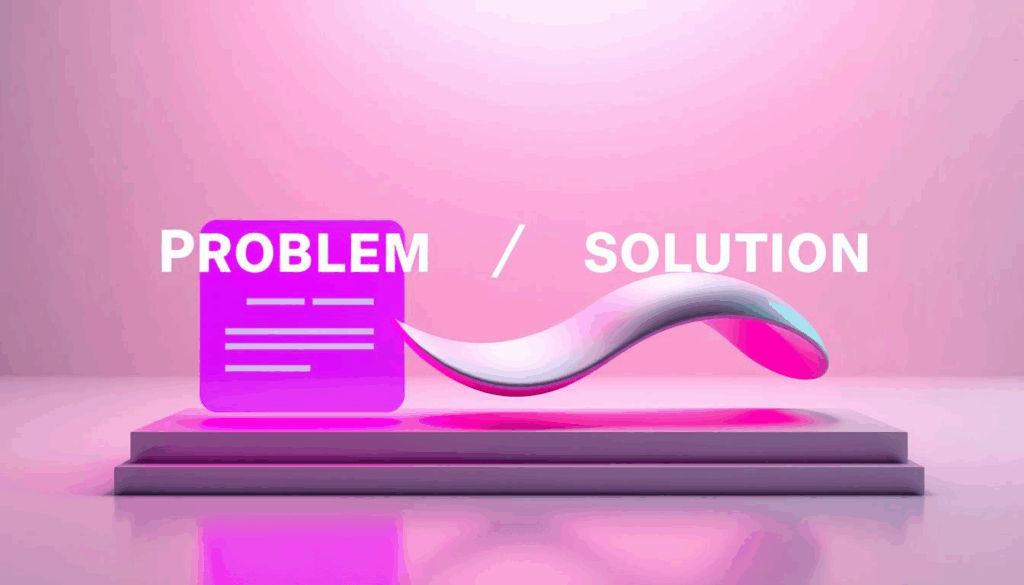As a seasoned SEO copywriter, I’ve witnessed firsthand the power of the problem/solution structure in content creation. This method consistently ranks high in search engines, making it a cornerstone of effective SEO. It’s vital to grasp the reasons behind its success.
Implementing this structure can significantly boost your website’s visibility and attract more visitors. In today’s digital world, a robust SEO strategy is indispensable. It’s the key to a strong online presence, thanks to the critical role of search engine optimization.

In this article, we delve into the significance of the problem/solution approach in SEO. We’ll discuss how it can elevate your website’s online presence. By the end, you’ll understand how to harness this structure to improve your digital visibility.
Power of Problem/Solution Content Structure
The problem/solution content structure excels by directly tackling user queries. It clearly outlines a problem and offers a fitting solution. This approach boosts user engagement and satisfaction. It’s especially valuable for website optimization, as it mirrors search engines’ content ranking criteria.

A leading SEO expert notes, “Content structured to solve specific problems ranks better in search engines.” This highlights the critical role of keyword research in content creation. It helps identify and tackle the issues your audience is searching for.
What Makes This Structure Effective
The problem/solution structure meets the user’s intent, offering the information they seek. This enhances user experience and boosts content sharing and linking. Effective content creation requires understanding your audience’s challenges and crafting content that solves them.
How Search Engines Respond to Problem/Solution Content
Search engines prefer content structured around a clear problem and solution. This aligns with their mission to deliver relevant results. By using relevant keywords, you can increase your content’s visibility in search results. This strategy makes your content both user-friendly and search engine-friendly.
In summary, the problem/solution content structure is a potent tool for boosting user engagement and search engine rankings. By grasping its effectiveness and how search engines react to it, you can craft content that resonates with your audience. This, in turn, enhances your website’s visibility.
Why Traditional Content Structures Often Fall Short
The traditional content structures fail to meet the evolving needs of users and search engines. This failure leads to content creators facing challenges in driving traffic, generating leads, or boosting conversions. It’s a clear indication of the need for a new approach.
To grasp the reasons behind the shortcomings of traditional content structures, we must look at common mistakes in content creation. We also need to understand the gap between what users intend to find and what content delivers.
Common Content Structure Mistakes
One major flaw in traditional content structures is the absence of a clear problem/solution framework. This framework is essential as it directly addresses user needs and offers a straightforward solution. Other common errors include poor keyword integration, inadequate internal linking, and a lack of engaging, high-quality content.
- Failing to understand the target audience’s pain points
- Not optimizing content for relevant keywords
- Neglecting to provide a clear call-to-action
Gap Between User Intent and Content Delivery
The gap between what users intend to find and what content delivers is significant. Users search for specific solutions to their problems, but traditional content structures often fail to provide these solutions effectively. By understanding user intent and crafting content that addresses it, creators can bridge this gap.
| User Intent | Traditional Content | Effective Content |
| Seeking a solution to a specific problem | General information without a clear solution | Directly addresses the problem with a clear solution |
| Looking for detailed product information | Lack of specific product details | Provides comprehensive product information |

Recognizing the shortcomings of traditional content structures is crucial. It highlights the need to align with user intent. Content creators can develop more effective SEO strategies by understanding both on-page and off-page SEO. Crafting content that resonates with the target audience is key.
Unlock Higher Rankings with the Problem/Solution Approach
Improving your search engine rankings is within reach with the problem/solution content framework. This method boosts your content’s visibility and offers real value to your audience. It directly meets their needs with relevant solutions.

Psychology Behind Problem/Solution Content
The problem/solution content structure taps into the user’s search intent. It frames content around a problem and its solution. This approach provides a clear path forward for users.
How It Triggers User Engagement
The framework engages users by addressing their needs and concerns directly. When content resonates with their problems and offers solutions, engagement increases.
Building Trust Through Solutions
Providing authoritative and relevant solutions builds trust with your audience. Trust is key in converting users into customers or achieving your content goals.
How This Structure Aligns with Search Engine Algorithms
Search engine algorithms aim to deliver the most relevant results. The problem/solution content structure meets this goal by addressing user queries and offering valuable content.
| Content Structure Element | Alignment with Search Engine Algorithms |
| Problem Statement | Directly addresses user search queries |
| Solution Section | Provides valuable and relevant content |
| Clear and Concise Language | Enhances readability and user experience |
Understanding the psychology behind problem/solution content and its alignment with search engine algorithms is crucial. It enables you to create content that resonates with your audience and boosts your search engine rankings.
Implementing the Problem/Solution Framework in Your Content
To effectively use the problem/solution framework in your content, start by understanding your audience’s challenges and needs. This framework works best when it’s tailored to your audience’s specific issues.
Identifying Your Audience’s Pain Points
Understanding your audience’s pain points is crucial for creating engaging content. Research your audience to grasp their challenges, needs, and preferences. This way, you can craft content that directly addresses their problems and offers effective solutions.
Crafting Compelling Problem Statements
After identifying your audience’s pain points, craft compelling problem statements. These statements should clearly outline the problems your audience faces. They should also prepare your audience for the solutions you’re about to present. A well-crafted problem statement can grab your audience’s attention and draw them into your content.
Developing Authoritative Solution Sections
The solution section is where you provide valuable advice to your audience. It should be detailed, well-researched, and relevant to the problem statement. By offering high-quality solutions, you help your audience and establish your authority in your niche.
By following these steps and effectively implementing the problem/solution framework, you can create content that resonates with your audience. This content addresses their needs and can improve your search engine rankings.
Optimizing Problem/Solution Content for SEO
To maximize the effectiveness of problem/solution content, it’s crucial to optimize it for search engines. A well-structured problem/solution content not only resonates with your audience but also improves your website’s visibility when properly optimized for SEO.
Keyword Integration Strategies
Effective keyword integration is vital for optimizing problem/solution content. This involves using both problem-focused and solution-focused keywords to cater to different search intents.
Problem-Focused Keywords
Problem-focused keywords are terms that users search for when identifying a problem. Incorporating these keywords into your content helps search engines understand the context and relevance of your problem statement. For instance, using keywords like “symptoms of” or “causes of” can help you rank for informational queries.
Solution-Focused Keywords
Solution-focused keywords, on the other hand, are terms that users search for when looking for solutions to their problems. These keywords can be incorporated into the solution section of your content, helping you rank for transactional or navigational queries. Examples include “best way to” or “how to solve.”
On-Page SEO Elements for Problem/Solution Content
On-page SEO elements play a significant role in optimizing problem/solution content. Some key elements to focus on include:
- Meta Title and Description: Ensure your meta title and description accurately reflect the content and include relevant keywords.
- Header Tags: Use header tags (H1, H2, H3, etc.) to structure your content and highlight important sections.
- Content Quality: Focus on creating high-quality, engaging content that provides value to your readers.
- Internal and External Linking: Use internal linking to connect relevant pages on your site and external linking to credible sources to enhance authority.
Measuring the SEO Impact of Your Structure
To understand the effectiveness of your SEO strategy, it’s essential to measure the impact of your problem/solution content structure. Use analytics tools to track your website’s traffic, engagement, and conversion rates. This data will help you refine your SEO strategy and make informed decisions for future content.
Case Studies: Problem/Solution Content Success Stories
Several case studies highlight the problem/solution content structure’s impact on website optimization. By offering clear solutions to specific problems, businesses have seen their search engine rankings improve. This has led to more traffic on their websites.
E-commerce Success with Problem/Solution Content
E-commerce businesses have greatly benefited from this approach. An online retailer focused on outdoor gear, for example, tackled customer concerns about product durability. They created detailed content that explained the durability issues and how their products solved them. This led to a 25% increase in organic traffic and a 15% boost in sales in just three months.
| Business Type | Problem Addressed | Results |
| E-commerce | Product durability concerns | 25% increase in organic traffic, 15% boost in sales |
| Service-Based | Inefficient service delivery | 40% increase in service inquiries, 20% rise in client engagement |
Service-Based Businesses Transformation
Service-based businesses have also seen significant improvements with problem/solution content. A consulting firm, for instance, addressed common challenges faced by their audience. They showed how their services provided effective solutions. This strategy resulted in a 40% increase in service inquiries and a 20% rise in client engagement within a quarter.
These examples demonstrate the problem/solution content structure’s versatility and effectiveness. It enhances content creation and SEO strategy across various business models.
Conclusion: Transforming Your SEO Strategy with the Problem/Solution Approach
Adopting the problem/solution content structure can greatly enhance your SEO strategy. It resonates with your audience and aligns with search engine algorithms. This leads to better search engine rankings.
To achieve higher rankings, understanding user engagement and SEO psychology is key. Crafting compelling problem statements and authoritative solution sections drives more traffic. This approach creates content that engages users and search engines alike.
Implementing this framework effectively, along with SEO optimization, can revolutionize your SEO strategy. By integrating relevant keywords and optimizing on-page elements, you can measure the SEO impact. This allows for data-driven decisions to enhance your online presence.
